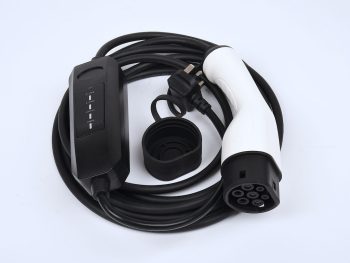Dangers of aftermarket EV charging cables revealed in new investigation
Aftermarket electric vehicle charging cables can pose a risk of overheating and electric shocks for users, an investigation by What Car has revealed.

What Car said all the charging cables were found to be unsafe, carrying risks of electric shock and overheating
It’s calling for a clampdown on third-party sales of EV charging cables after laboratory tests revealed serious dangers.
The car magazine bought three ‘Mode 2’ chargers, able to operate from a three-pin domestic socket. They were tested in an electrical laboratory and assessed for conformity with British and European safety standards.
The investigation – full details here – indicated that all three ‘granny chargers’ were unsafe. All the cables tested were said to have poorly worded instructions, unclear levels of water resistance and carry the risk of overheating and electric shock.
Each cable was subjected to five different Residual Current Device (RCD) tests. Two cables failed all five RCD tests by the lab, and one cable passed only one of the tests. The RCD works by switching off the electricity automatically if a fault is detected – but if the system doesn’t react quickly enough or appropriately, there is a serious risk of electric shock to anyone using it.
The lab also tested each cable’s plug to ensure it fitted properly into a socket – none did, bringing a risk of overheating, particularly if the cable is left plugged in for many hours.
In addition, it was noted that all three cables were designed to run at more than 13 amps, whereas the plugs were only rated up to 13 amps. While this additional current is unlikely to blow a fuse, it will generate extra heat and, over prolonged periods, could make the plug get hot enough to burn someone.
Visual tests on the safety labelling and resistance to tampering showed that all three cables had data panels on their control units, but the information was poorly worded and did not clearly state the safety regulations that each device adhered to. Labelling on the level of water resistance was also unclear – despite the fact that this is an essential feature as the units are highly likely to be used outside.
The cables were bought from two online marketplaces: Amazon and Componentauthority.com. Online third-party sites are not legally obliged to check the safety of the products they sell in the same way as high street retailers, so it can be easy for sellers to offer sub-standard products via them – and What Car is now calling for stricter regulations on the sale of all electrical goods, including EV charging cables, via online marketplaces.
While Amazon has now told What Car it’s removed the charging cables from sale while it investigates the findings, Componentauthority.com hasn’t offered to do so.
Claire Evans, What Car consumer editor, said: “Our tests show how easy it is to buy unsafe EV charging cables online. Our investigation highlights the importance of choosing electrical products with care and we recommend buying from reputable high street or online retailers. We believe stricter regulations for third-party sellers are needed. They should check that products meet the relevant standards up front, rather than retrospectively, following a complaint or investigation.”
Charging cable test results
| EVCARS Mode 2 EV Charger(via Amazon) |
Oasser Mode 2 Electric Vehicle Charger
(via Amazon) |
Portable EV Charger
(via componentauthority.com) |
|
| Price | £169 | £130 | £108 |
| RCD Test | FAIL – failed 5/5 tests | FAIL – failed 4/5 tests | FAIL – failed 5/5 tests |
| Plug Test | FAIL – non-EV rated and poor fitting into socket | FAIL – non-EV rated and poor fitting into socket | FAIL – non-EV rated and poor fitting into socket |
| Labelling | Correct CE info, but no clear safety regulations | Correct CE info, but no clear safety regulations | No clear CE info, no clear safety regulations |
| Instructions | Provided | Provided | Not provided |
| Weather Resistance | IP66-rated but states don’t use in rain | IP67-rated but states don’t use in heavy rain | No IP rating |
| Conclusion | UNSAFE | UNSAFE | UNSAFE |

